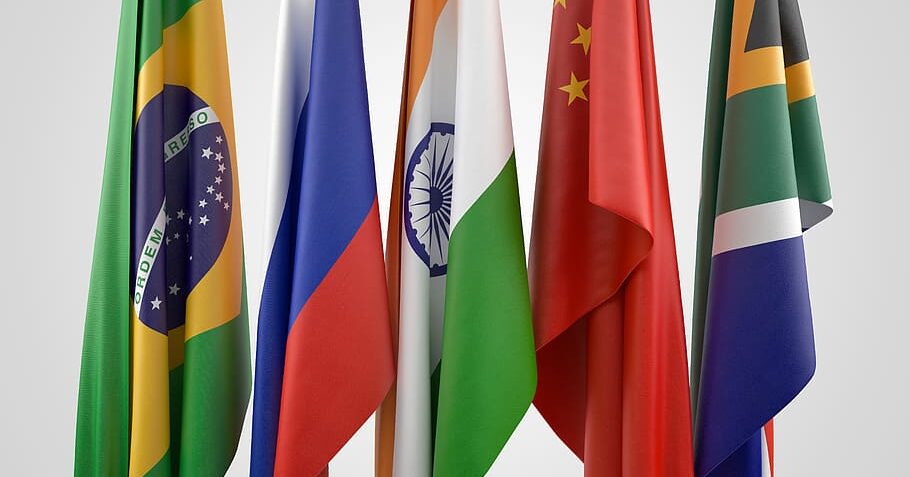

By Peter Main
At its August conference in South Africa, the BRICS group of ‘emerging markets’ (Brazil, Russia, India, China and South Africa) agreed to accept six new members.
Their decision prompted speculation that the enlarged group represented a challenge to the G7 bloc of the USA, Canada, Germany, France, UK, Japan and Italy that has largely dominated the global economy since its formation in the aftermath of the ‘oil price shock’ of the 1970s.
On paper, at least, this looks like a real possibility. Taken together, the G7 countries represent just 9.8% of the world’s population and 29.8% of its GDP, measured by Purchasing Power Parity, while the new BRICS+ accounts for 47 percent of the population and 37 percent of GDP, by the same criteria.
Such statistics, however, are far from telling the whole story. It is the G7 countries, in essence the USA, that control the world’s financial and trading systems through such bodies as the International Monetary Fund and the World Bank. Producing a lot of goods or raw materials is one thing, controlling the currency in which they have to be traded is quite another. Add to that the power to decide interest rates and to dictate the conditions for international loans and investment, and the reality of the global balance of power becomes clearer.
Prospects
Does this make the BRICS conference little more than an elaborate photo opportunity for the world’s also-rans? Almost certainly not. Even a brief review of the group’s evolution points to growing significance and a future leading role on the world’s stage. The idea that Brazil, Russia, India and China could form a powerful economic bloc was first put forward by a Goldman Sachs economist, Jim O’Neil, in 2001. He projected the growth rates each had reached in the first decade of ‘globalisation’ and concluded that, if they cooperated, they could dominate the globe by 2050. In particular, he saw China and India as industrial giants, supplied with raw materials and energy by Brazil and Russia.
At the time, the four states had no common organisation, but the numbers did add up. While Goldman Sachs was interested in advising investors, its continued monitoring encouraged the countries’ leaders to draw their own conclusions. The first informal meeting took place in 2006, leading to a summit, held in Russia, to establish a formal grouping in 2009. The following year, China proposed South Africa’s membership and this was agreed, creating BRICS.
From the very first meeting, the grouping identified the need for a new reserve currency, a clear challenge to the US dollar. While progress has been intermittent, BRICS has now established the New Development Bank and created a reserve currency fund. The fundamental importance of this issue was underlined by the ability of the US and its allies not only to impose sanctions on Russia immediately after the invasion of Ukraine, but also to seize its overseas assets. The implications were not lost on many countries who could imagine themselves falling foul of Washington’s policies. Little wonder, then, that 40 countries expressed an interest in joining BRICS and 23 formally applied to join, even if only six, Argentina, Egypt, Ethiopia, Iran, Saudi Arabia and the United Arab Emirates, were actually accepted.
The expanded group, BRICS+, which will come into existence in January 2024, will receive reports on increased use of local currencies for trade and the creation of a new payment system and trading platforms when it meets, under Vladimir Putin’s chairmanship, in Kazan, next year. The potential economic significance of the new group is immediately obvious, especially with regard to energy and raw materials. Already, again under the impact of Western sanctions, trade between several of these countries is now in local currencies and, increasingly, the Chinese yuan.
Challenges
Undoubtedly, there are also great disparities and rivalries within BRICS+, and the world is not about to see a complete reversal of the balance of power. The reported decision by Xi Jinping not to attend the next meeting of the G20, to be hosted by India’s Narendra Modi, in September, points only to the most obvious potential division in the new bloc. We shall see if this is simply a snub to Modi, an assertion of the greater weight of China, or a strategic decision to downgrade the G20 bloc, which was itself only formed to cope with the aftermath of the Great Recession and is still some way from establishing itself as an autonomous power.
India may be very wary of China, but also expects a greater role globally and could see the BRICS+ as a step towards its own goals. Modi is on record as saying that the new organisation could, ‘become an example for the reform of other global institutions established in the 20th Century’. Or ‘the UN Security Council’, as others might put it.
What is undeniable is that the rivalry between the main imperialist powers, US/NATO, Russia and China, which has already escalated beyond anything seen in several decades, does not take place in a vacuum, leaving other states simply as onlookers. For the overwhelming majority of humanity, a secure future depends not on the victory of one or another bloc of ‘Great Powers’, but the collective defeat of all of them by the international working class.